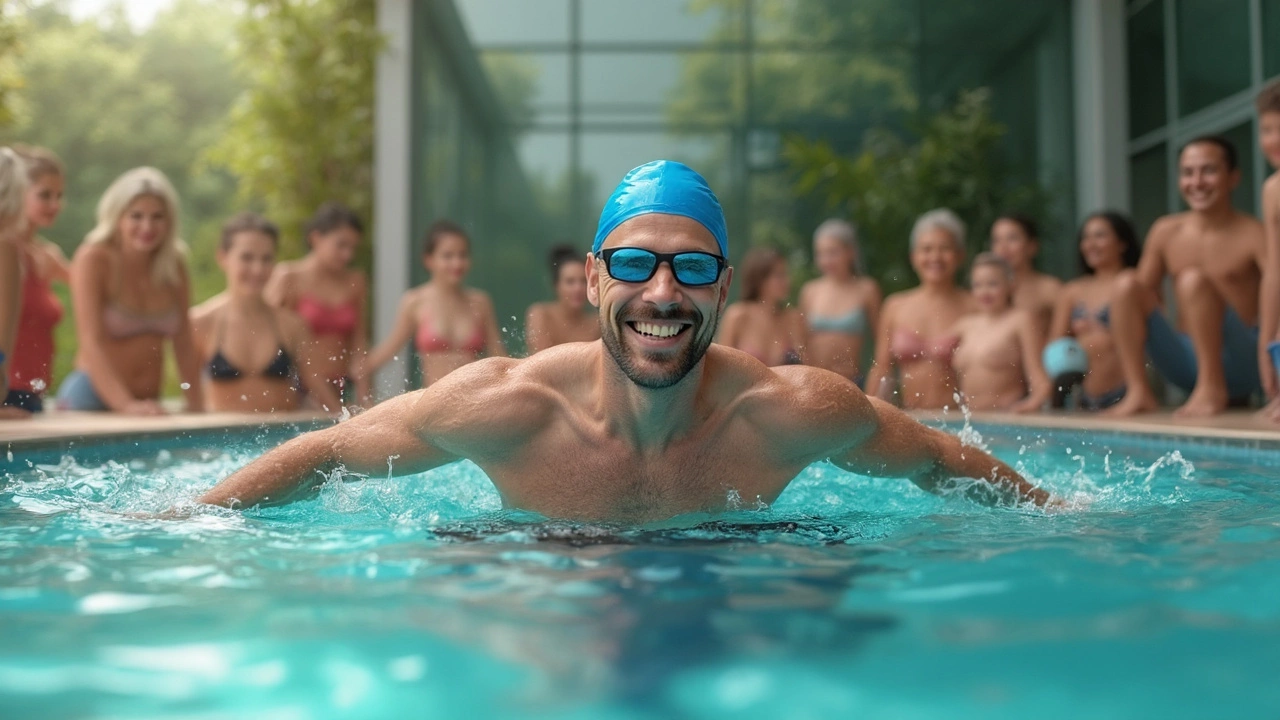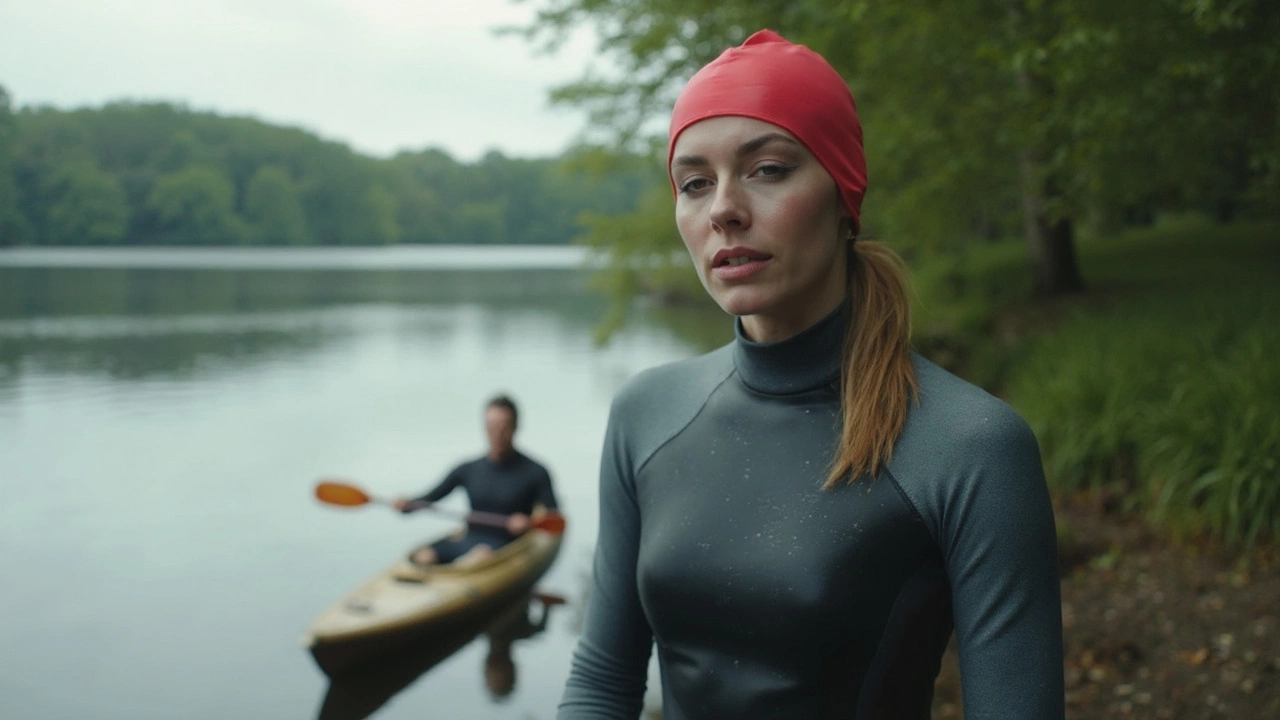How Long Does It Take to Learn Swimming as an Adult?
 Feb, 9 2025
Feb, 9 2025
Ever thought about diving into the world of swimming as an adult? It's totally doable—no matter your age or starting point. Of course, the big question everyone asks is, 'How long will it take to actually swim without gulping down half the pool?' Well, it varies for everyone.
Most folks can pick up the basics in about 20-25 hours of lessons, spread across several weeks. But let's keep it real: your comfort level with water, your previous experiences, and how often you practice play a huge role.
Here's a cool tip: focus on getting comfortable in the water first. Spend time just being in the pool, feeling how your body moves. Trust me, comfort is half the battle won!
- Understanding the Basics
- Factors That Affect Learning Time
- Tips for Faster Learning
- Common Challenges and Myths
Understanding the Basics
So, let's break down what you really need to know before taking your first plunge into learning to swim as an adult. First off, remember that swimming is a life skill that combines breathing, coordination, and movement.
Breathing Techniques
Getting the hang of breathing is step one. When you're swimming, you’ll need to get comfortable with exhaling underwater and inhaling above the surface. Try standing in the shallow end and blowing bubbles through your nose and mouth—think of it like whistling underwater.
Floating and Buoyancy
Ah, yes, floating! Our bodies are naturally buoyant, but it’s normal to feel a bit heavy at first. To float, try lying back in the water and relaxing your body. Spread your arms and legs to form a star shape, and let the water do its thing.
Basic Strokes
Starting with basic strokes, like the freestyle or breaststroke, can build confidence. You can start by holding the side of the pool and kicking your legs like when you're riding a bike. Once you get that down, practice arm movements on dry land before combining both in the water.
- Freestyle: Known for its simplicity, this stroke requires you to alternate your arms while keeping your body as straight as possible.
- Breaststroke: A bit slower but easier on the body, with simultaneous arm and leg movements like a little frog.
Here’s a fun fact: When you learn to swim, it’s not just about physical movements. It's also about building confidence and trust in the water. The more relaxed you are, the better you'll perform.
Factors That Affect Learning Time
Learning to swim as an adult isn't a one-size-fits-all journey. How quickly you get the hang of it depends on a bunch of different things. Let's break down some of the main factors.
Your Comfort with Water
If you're the type who loves hanging by the pool or diving into the ocean, you're in a good spot. Being comfortable around water can cut down the learning time because you're less likely to panic or feel tense.
Fitness Level and Physical Health
Being in decent shape can be a plus. Swimming uses a lot of muscles, so if you've got some fitness under your belt, that's going to help. But hey, don't sweat it if you're not there yet. People start from all kinds of fitness levels and do just fine.
Frequency of Practice
Remember those college days when you crammed? Well, learning to swim is kind of the opposite. Regular practice is key. Hitting the pool a couple of times a week helps you improve faster than trying to do it all in one go.
Quality of Instruction
Not all lessons are created equal. Good instructors make a difference. They provide tips and feedback that really help you move forward. Trust in your instructors to guide you through the steps, and don't be afraid to ask them questions.
Personal Persistence and Patience
It sounds cliché, but persistence pays off. Sticking with it, even when progress feels slow, is super important.
Adult Learning Curve
Adults often have the challenge of unlearning some preconceived notions or fears about water. Kids tend to embrace new activities without overthinking them, whereas adults may be more cautious. But don't let that mindset hold you back! Embrace the process, and you'll surprise yourself with what you can achieve.
A study showed that adults who swim at least twice a week can significantly improve their skills within six weeks. So, if you're ready to get that water confidence, dive in and make a splash with your swimming journey!

Tips for Faster Learning
Alright, so you want to speed up your learn to swim journey? Here are some practical tips that'll have you gliding through the water in no time.
1. Consistency is Key
The best way to get better at anything, including swimming, is to practice regularly. Try to hit the pool at least 2-3 times a week. Consistent effort beats sporadic marathon sessions any day.
2. Focus on Technique
Don’t just flail around. Pay attention to your technique. Consider getting a swimming instructor to correct your form—it’s way easier to build on good habits than to break bad ones later.
3. Break It Down
Instead of trying to master everything at once, break down the skills into manageable chunks. Start with floating and kicking before you tackle full-on strokes.
4. Use Floatation Devices
Kickboards and pull buoys can be your best friends. They help you focus on specific skills without worrying about staying afloat.
5. Breath Control
Many beginners struggle with breath control. Practice breathing exercises outside and inside of the water to get more comfortable. It’s all about timing and rhythm.
6. Set Small Goals
Big goals can be daunting. Set small, achievable goals like swimming one length of the pool without stopping. Celebrate these wins!
| Practice Frequency | Improvement Rate |
|---|---|
| 1x per week | Slow |
| 2-3x per week | Moderate |
| 4-5x per week | Fast |
Remember, everyone learns at their own pace. Keep a positive mindset, and don't get discouraged by comparing your progress to others. Happy swimming!
Common Challenges and Myths
Learning to swim as an adult comes with its fair share of hurdles, but often what's holding us back are misconceptions rather than actual obstacles. Let's set the record straight and tackle some real challenges along the way.
Fear of Water
Many adults are a little (or a lot) scared of water. Maybe you had a bad experience or just never got comfy with being submerged. The key here is to take baby steps and gradually build up your confidence. Start with shallow water and work your way up. Try simple breathing exercises and floating to get used to the sensation.
Belief that It's Too Late
Ever heard someone say, "You can't learn new tricks when you're old"? It's a myth! In reality, adults can learn to swim just as well as kids. Sure, you might not end up winning Olympic medals, but you'll definitely become proficient enough to enjoy the water.
Expectations vs. Reality
Some believe they'll master swimming in a couple of lessons. The truth is, learning to swim takes time and persistence. Stick with it, schedule regular practice, and celebrate small victories along the way.
Getting the Right Technique
Many struggle with coordinating breathing and stroke technique. It's nothing to stress over. Focus on one skill at a time, maybe with a swimming lesson instructor or videos. Patience is your best friend here.
Physical Condition Concerns
Worried you're not fit enough? Swimming is actually fantastic for people of all fitness levels. It's low-impact and great for building endurance gradually.
Consider this: in a survey of adult swimmers, 70% mentioned that their hesitation was more in their minds than in the water. And hey, once they gave it a shot, they found the rewards super satisfying.